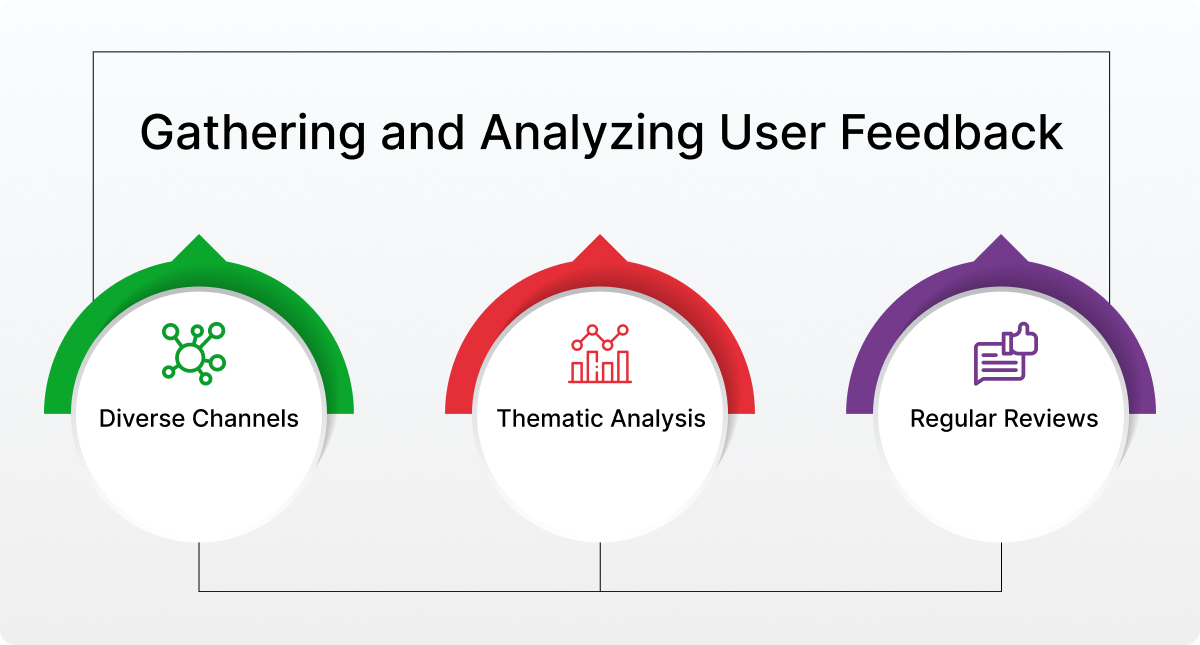Having a chatbot that’s not just a passive tool but a dynamic force bolsters your brand’s reputation. Your bot needs to be the best at winning people over with its conversation.
But how do you ensure your chatbot reaches its full potential? How do you transform it from an automated response mechanism into a true powerhouse of success? The answer lies in our ultimate checklist, carefully curated to steer you toward achieving a high chatbot success rate.
In the following pages, we’ll walk you through the most essential items on this checklist. Each item is a critical building block, a piece of the puzzle that will take your conversational AI from ordinary to extraordinary.
So, get ready to unlock the secrets behind chatbot success and equip yourself with the tools you need to elevate your venture to new heights.
Checklist for Achieving Chatbot Success Rate
In this section, we will dive deep into the essential elements of achieving a high chatbot success rate. You’ll discover actionable strategies and best practices to transform your chatbot into a powerful tool. It will take care of user experiences, fosters engagement, and drives business growth.
Define Clear Objectives
This term might sound straightforward, but it’s the very first prerequisite to set for your digital message conveyor’s success. It entails setting explicit, well-defined goals that align with your organization’s mission and business objectives.
By doing so, you’re not just giving your chatbot a sense of purpose, but also equipping it to better serve your customers.
Importance of Setting Clear Chatbot Objectives
Imagine setting out on a journey without a destination in mind; the chances of reaching your desired endpoint are slim. Similarly, chatbots without clear objectives often wander aimlessly, leaving users frustrated and your business goals unmet.
When objectives are precisely defined, your conversing software gains direction and purpose. It knows its role and how to assist users effectively.
Well-Defined Goals for Better Success Rates
Well-defined chatbot objectives are intrinsically linked to better success rates. These objectives act as the guiding star for your chatbot, ensuring it consistently delivers value to users.
They reduce ambiguity and align chatbot actions with the desired outcomes, ultimately enhancing the user experience.
Objectives in Different Industries
With not limited to a specific industry; Chatbots are versatile tools that can adapt to various sectors. To illustrate the significance of well-defined objectives, let’s explore examples from different industries:
- In e-commerce, a chatbot’s objective might go beyond merely providing information. It could be designed to guide users through the purchase process. That means assisting with product selection, sizing recommendations, and cross-selling related items.
- Within the healthcare industry, web-based bot objectives often revolve around patient engagement and support. A healthcare chatbot’s primary goal might be to help patients schedule appointments.
It also could involve providing them with medical advice based on their symptoms or offering medication reminders.
- In the tech industry, chatbots can be deployed to address a wide range of customer support issues. The primary objective might be to troubleshoot common technical problems. It can help users resolve issues with their devices or software.
This is a methodology for creating a chatbot interface that prioritizes the user’s needs and preferences. This approach ensures that your conversing software engages users effectively, fosters positive interactions, and keeps them coming back for more.
Need for a User-Friendly Chatbot Interface
User-friendliness isn’t just a nice-to-have; it’s a must. Users want interactions that are smooth, intuitive, and responsive. A user-friendly bot interface minimizes user effort, making it easier for them to get the information or assistance they need.
Impact of Design on User Engagement
The design of your digital message conveyor interface directly influences user engagement. An appealing, user-centric design not only grabs users’ attention but also encourages them to explore and interact.
On the flip side, a poorly designed interface can frustrate users, leading to dissatisfaction and lower engagement rates.
User-Centric Chatbot Design Tips

Now, let’s delve into three key tips for creating a user-centric chatbot design:
- Simplify the User Journey: To simplify the user journey, you can start by mapping out potential user interactions and identifying common paths. By understanding how users typically navigate your chatbot, you can streamline the conversation flow.
- Embrace Visual Appeal: Visuals can convey information more effectively than text alone. For example, if a user asks about clothing styles, your conversing software can respond with images showcasing different styles, making the response more informative and engaging.
- Provide Clear Guidance: When a customer asks about available services, your virtual chat assistant can provide a list with clear options and encourage the user to select one.
Additionally, it can offer help or suggestions if the user seems unsure about their next move. Clear guidance reduces user frustration and encourages continued interaction.
Natural Language Processing Integration
Here you will get to know the most pivotal aspect of chatbot interaction, and that is the integration of Natural Language Processing (NLP). NLP is the technology that empowers chatbots to understand and respond to natural language, serving a more human-like conversation experience.
Role of NLP in Improving Chatbot Interactions
NLP is a multi-faceted tool that revolutionizes chatbot interactions in several key ways:
- Contextual Understanding: NLP enables chatbots to grasp context, allowing them to maintain coherent and relevant conversations. This means chatbots can comprehend follow-up questions and maintain conversational threads.
- Language Variability: NLP equips chatbots to understand different accents, languages, and dialects. It’s a global communicator, breaking down language barriers and allowing users from diverse backgrounds can engage with your chatbot effectively.
- Sentiment Analysis: These analysis capabilities empower chatbots to detect user emotions. By understanding whether a user is happy, frustrated, or confused, bots can tailor their responses, providing empathy and support as needed.
How NLP Enhances Understanding
One of NLP’s most remarkable features is its ability to enhance understanding in chatbot interactions. It achieves this by parsing and interpreting the subtleties of natural language.
For example, when a user employs sarcasm, irony, or humor, NLP can decipher these nuances. It makes sure that chatbot responses align with the intended tone and context.
NLP Integration Best Practices
Integrating NLP effectively into your digital message conveyor involves adhering to best practices:
- Regular Training: Continuously train your NLP model with new data to keep up with evolving language patterns and user preferences. This safeguards the accuracy and up-to-date of your conversing software’s understanding.
- Customization: Customize your NLP model to suit your industry or specific use case. Tailoring NLP to understand industry-specific terminology and user intents enhances the chatbot’s relevance and usefulness.
- Quality Data Sources: Your NLP model needs to draw from high-quality, diverse data sources. Quality data is the foundation of accurate language understanding, making it crucial for effective integration.
Robust Knowledge Base
This is the foundation of your conversing software’s intelligence. It serves as the reservoir of information that your chatbot relies on to provide accurate responses and valuable insights.
Importance of a Comprehensive Knowledge Base
A comprehensive knowledge base is invaluable for several reasons:
- Knowledge Repository: It acts as an extensive repository of information that your virtual chat assistant taps into. This means that your conversing software can respond to a wide range of user inquiries, from product details to troubleshooting guidance.
- User Confidence: Users rely on your chatbot for accurate, trustworthy information. A comprehensive knowledge base ensures that users can trust the responses they receive.
- Consistency: With a well-maintained knowledge base, your text chat agent can provide consistent information and responses across various channels. Consistency is key to building and maintaining a positive user experience.
Role of Accurate Information in User Satisfaction
The accuracy of the information in your knowledge base is directly proportional to user satisfaction. When users receive precise and reliable information, they’re more likely to have their needs met and feel satisfied with their interactions.
For example, in a customer support chatbot, accurate instructions for troubleshooting a technical issue can lead to problem resolution and user delight.
Knowledge Base Maintenance Tips
Effective maintenance of your knowledge base is vital for sustained chatbot success:
- Regular Updates: Keep your knowledge base up-to-date with the latest information, product updates, and frequently asked questions. Your digital message conveyor must have access to the most current data.
- Quality Control: Implement quality control measures to verify the accuracy of information within your knowledge base. This can involve periodic reviews and audits to identify and rectify inaccuracies.
- Feedback Integration: Integrate user feedback into your knowledge base maintenance process. User comments and inquiries can highlight areas where the knowledge base needs improvement or expansion.
Effective Conversation Flow

Effective conversation flow gives chatbots the best of their characteristics. Uninterrupted conversation flow is the very first thing that people engaged in a conversation expect.
Impacts of Smooth Conversation Flow
A smooth conversation flow holds the power to:
- Enhance User Engagement: When users can interact seamlessly with a chatbot, they’re more likely to engage, ask questions, and seek assistance. A convoluted or confusing conversation flow can deter users from continuing their interaction.
- Reduce User Frustration: An erratic or broken conversation flow can lead to user frustration. Users expect clear, straightforward interactions that provide them with the information or assistance they seek.
- Drive Desired Actions: Whether it’s making a purchase, scheduling an appointment, or finding specific information, the conversation flow should naturally guide users in the right direction.
Conversational Elements That Work Well
Two conversational elements that consistently work well are:
- Open-Ended Questions: Encourage users to share more about their needs and preferences through open-ended questions.
For example, asking a user, “How can I assist you today?” invites them to express their specific needs.
- Clear Navigation Prompts: Providing users with clear navigation options is essential. For instance, using prompts like “Would you like to explore our product catalog, get support, or schedule an appointment?” offers users a straightforward way to choose their desired path, enhancing the user experience.
How to Optimize Chatbot Dialogue
To optimize chatbot dialogue, consider the following three strategies:
- Contextual Relevance: Your assistant bot needs to through contextually relevant responses. If a user asks a follow-up question, the chatbot should reference previous interactions to provide an accurate and consistent response.
For example, suppose, a customer previously inquired about “product features,” and they later ask, “Tell me more about pricing.” The text chat agent should understand the context and offer pricing information related to the product features discussed earlier.
- Personalization: Personalization is key to creating a tailored user experience. Your online talking bot should remember user preferences and use this information to provide personalized recommendations or responses.
For instance, if a user frequently orders a specific type of product, the chatbot can proactively suggest related products based on the user’s history.
- Adaptive Language: If a customer engages formally, the conversation software’s responses should follow suit. If he/she adopts a casual or informal tone, the chatbot should adapt accordingly.
For example, if someone asks a question using emojis or informal language, the chatbot’s response can use a similar style to create a more engaging conversation.
Multichannel Integration
Here, we’ll unwrap the necessity of multichannel integration in exchanging information with bots. It refers to the practice of making your chatbot available on various communication channels to expand its reach and accessibility.
Benefits of Being Available on Multiple Channels
Being available on multiple channels offers a multitude of benefits:
- Increased Accessibility: It means that users can engage with your text chat agent through their preferred channels, whether it’s a website, social media, messaging apps, or voice assistants.
- Enhanced User Engagement: Different users have different communication preferences. By being present on various channels, you cater to a diverse user base. This variety leads to increased engagement, as users can choose the channel.
How Multichannel Integration Can Improve Success Rates
Multichannel integration can improve chatbot success rates by expanding reach. That means being present on multiple channels to get exposure to a broader audience. It results in driving higher success rates across different segments.
Additionally, offering users the convenience of choosing their preferred communication channel extends the experience to better mileage. This, in turn, leads to a higher success rate as users are more likely to return and interact with your conversing software again.
Implementing Multichannel Strategies
To effectively implement multichannel strategies, consider the following insights:
- Channel Selection: Carefully choose the channels that align with your target audience. Understanding where your users are most active helps you focus your efforts and resources on the channels that matter most.
- Consistent Branding: Ensure consistent branding and messaging across all channels. Users should have a uniform experience, regardless of where they engage with your chatbot.
This duo claims to be there to provide users with tailored, relevant interactions. Personalization, on one end, involves customizing the bot’s responses to match the preferences and characteristics of individual users.
On the other edge, context awareness equips the text chat agent with understanding the context of the conversation and adapts its responses accordingly.
Role of Personalization in User Engagement
Personalization plays a crucial role in user engagement. It fosters a more meaningful connection between users and your text chat agent, leading to higher engagement levels. Users feel valued and understood when the chatbot tailors its responses to their preferences and needs.
Context Awareness on the User Experience
The ways, in which context awareness reigns over the user experience, are given below:
- Seamless Conversations: Context awareness allows chatbots to maintain a coherent conversation flow. So, the chatbot understands follow-up questions and references prior interactions, making the conversation feel more natural and user-friendly.
- Relevance: If a customer was previously inquiring about “beach vacations”, they can come later and ask about “local attractions.” The virtual assistant can link the two topics and provide information about local attractions at popular beach destinations.
Implementing Personalization and Context Awareness

To implement personalization and context awareness effectively, consider the following tips:
- User Profiling: Create user profiles based on their interactions and preferences. This enables your virtual chat assistant to remember user-specific information and offer personalized recommendations or responses.
- Context Retention: Ensure that your conversing software retains conversation context. This allows it to understand follow-up questions and maintain a consistent conversation flow. A user should be able to resume a conversation naturally, even after a break.
- User Consent: Obtain user consent for collecting and using their data for personalization. Transparency and consent are essential to respect user privacy and build trust.
Regular Monitoring and Maintenance
Regular monitoring and maintenance are the backbone of a progressive bot. If you want it to play along with your rules, you must check whether it follows the rules or not.
Importance of Continuous Monitoring
Monitoring helps chatbots perform at their best and deliver accurate responses. Regular checks help identify and rectify any issues that may arise, maintaining the quality of user interactions.
User preferences and language patterns change over time.
Continuous monitoring enables your chatbot to adapt to these shifts, keeping its responses relevant and up-to-date.
Regular Updates on Success Rates
Regular updates can address issues and improve success rates by analyzing chatbot interactions. It lets you identify areas where responses can be improved. Regular updates help fine-tune the conversation software’s language and recommendations for better user satisfaction.
Moreover, being updated means getting to know about bugs or errors in the text chat agent’s functionality. It results in reducing the likelihood of user dissatisfaction due to technical issues.
To-Do List for Ongoing Chatbot Maintenance
You need to regularly monitor and optimize the chatbot’s performance to keep it aligned with user expectations and industry trends. Continuous maintenance enhances user satisfaction and the chatbot’s effectiveness. You can stick the following to-dos in your checklist:
- Regularly analyze user feedback for response and personalization improvements
- Test chatbot responsiveness during peak usage for scalability
- Address bugs and errors (technical issues) and solve them promptly
- Keep data current and verify accuracy in the knowledge base
User Feedback Analysis
Here, you will understand the gist of how user feedback analysis can uplift the response condition of a chatbot. This analysis carries collecting and comprehending user comments and suggestions to energize the conversation software’s performance.
Significance of User Feedback
User feedback holds immense significance in the following ways:
- User-Centric Improvements: Its valuable insights into user experiences, preferences, and pain points enable chatbot enhancements that directly cater to user needs.
- Continuous Enhancement: Ongoing user feedback analysis ensures that your digital message conveyor evolves in sync with changing user expectations and technological advancements.
Feedback Analysis on Improvements
User feedback analysis leads to improvements by identifying areas for optimization and enabling data-driven decision-making. By systematically evaluating feedback, you can pinpoint recurring issues, prioritize improvements, and implement changes.
Gathering and Analyzing User Feedback: Best Practices

To effectively gather and analyze user feedback, consider these best practices:
- Diverse Channels: Collect feedback from diverse channels, including chat transcripts, surveys, social media, and direct user interactions, to obtain a comprehensive view of user sentiment.
- Thematic Analysis: Categorize user feedback into themes such as usability, content accuracy, and responsiveness. It facilitates a structured approach to improvement prioritization.
- Regular Reviews: Conduct routine reviews of user feedback to track trends and patterns. Then the text chat agent remains aligned with evolving user needs and expectations.
Chatbot Success Rate Tracking Metrics
Now, it’s time to get an overview of how much the chatbot meets your target. This is the place where you will have the metrics in your hand to measure. They bring to you the quantitative and qualitative reports that present the conversation software success rates.
Performance Metrics in Evaluating Success
These metrics encompass parameters like user satisfaction, response time, accuracy, and task completion rates. They provide an objective measure of how well the chatbot meets user needs and business objectives.
Essential Chatbot Success Rate Metrics
Though there are many measurement tools out there, you need to cover these three anyhow. After all, most tools jump to this conclusion in their unique ways.
- User Satisfaction: Measured through user surveys or post-interaction feedback, user satisfaction gauges how content users are with their chatbot interactions.
- Task Completion Rate: This metric tracks the percentage of completed tasks by users when interacting with the text chat agent.
- Response Time: It measures the time it takes for the chatbot to respond to user inquiries, with shorter response times typically indicating a better user experience.
Creating Effective Performance Reports
For decision-making and accountability, these reports give clear and concise views. They provide actionable insights based on performance metrics. Consequently, you get not only a better sight of the areas that need improvement but also guidance with initiatives to take for particular areas.
Conclusion
Among this checklist for maximizing the chatbot success rate, user feedback analysis stands out. Installation of the entire system is the easy part but going along with it leads toward the goal and that is challenging.
Just diligently stick to this checklist, and your conversational bot will surely achieve its boundless potential. Feedback analysis, in fact, inevitably attaches to the ever-changing needs of users and the evolving landscape of technology.
So, establish this micro-task into your big system hierarchy your chatting software will automatically evolve with time. Ready to Supercharge Your Chatbot? Start Now!
This is Kawser Md Sayem, and I would like to introduce myself as a content writer. It has been five years since I began my professional writing journey. By this time, I have had the pleasure of working in unidentical industries like publishing, information technology, entertainment, and education
 Chatbot
Chatbot





